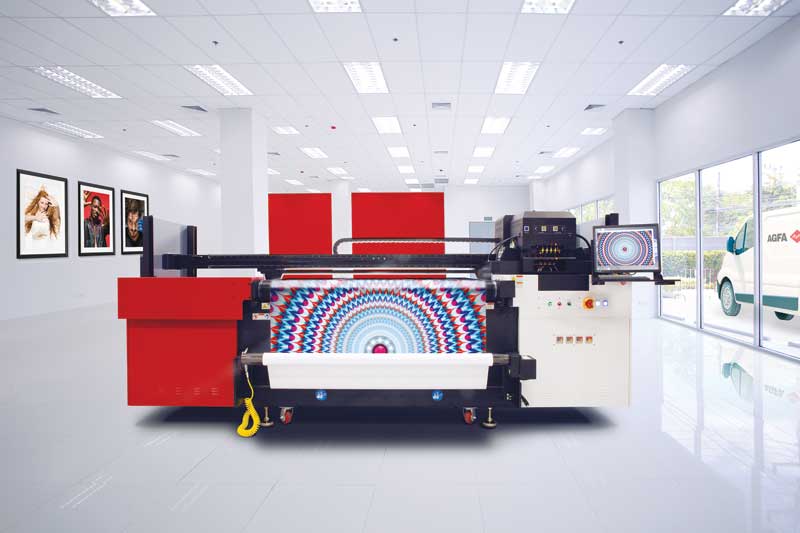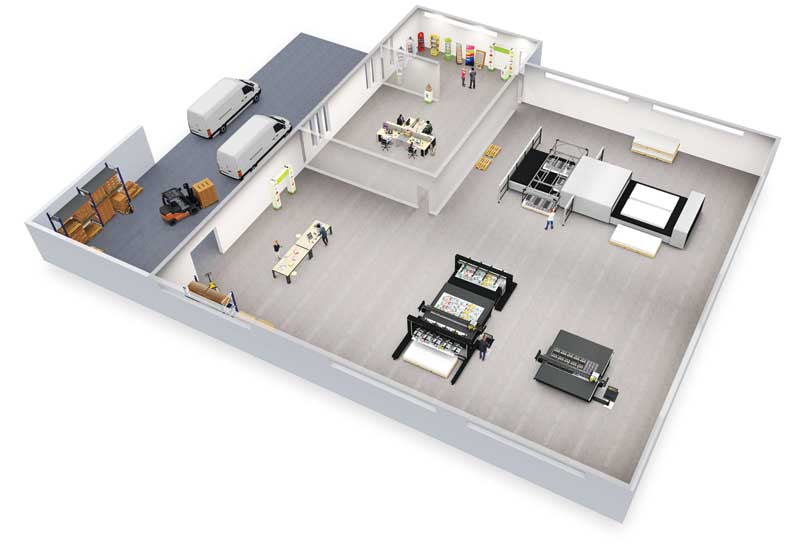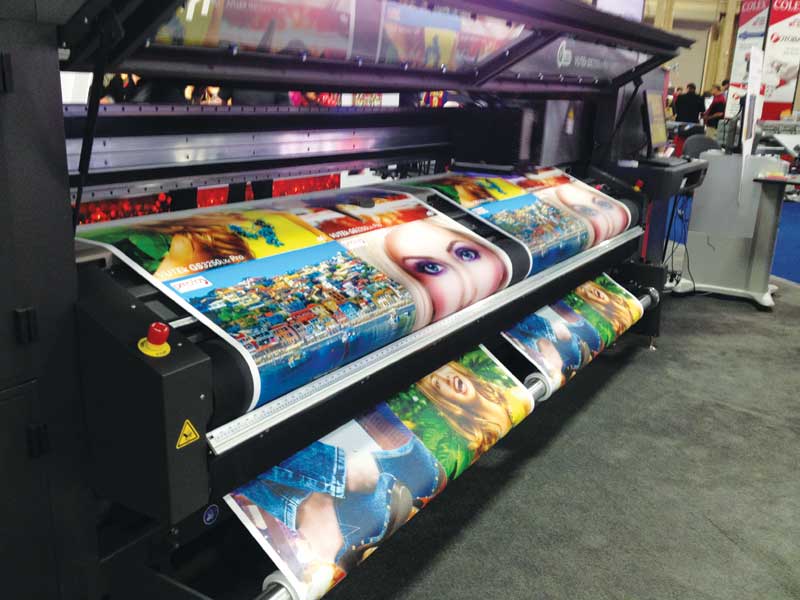Wide-format Printing: Capturing new opportunities
by all | 14 May 2018 9:15 am
 [1]
[1]Photo courtesy Agfa Graphics
By Eve Padula and Steve Urmano
Today’s wide-format digital print service providers (PSPs) have an increased number of opportunities to broaden their offerings and increase revenue. To do so, however, they must contend with an increasingly crowded marketplace and fierce competition.
An extensive product line can help sign companies reach new market segments, but new printers, inks and substrates can only go so far without keeping an eye on overall production processes. An efficient workflow depends on many steps, from design creation to prepress to client approval to shipping.
A lucrative market
According to research firm InfoTrends (now part of Keypoint Intelligence), global volumes of digitally printed wide-format graphics are currently experiencing a compound annual growth rate (CAGR) of eight per cent, rising from approximately 2.2 billion m2 (24 billion sf) in 2015 to 3.3 billion m2 (36 billion sf) by 2020. Durable aqueous ‘latex’ inkjet printing, dye sublimation and ultraviolet-curing (UV-curing) presses are driving much of this growth.
Posters and banners remain staples of the market. Backlit displays, with their luminous qualities and illusion of depth, can make graphics more eye-catching and memorable. Full-colour window graphics can achieve a similar effect.
Floor graphics have proven useful for branding, promotional messages and wayfinding, with overlaminates providing durability and slip resistance to self-adhesive films. Wallpaper, panels and glass provide further indoor surfaces for printed graphics.
Layering techniques can be used to create textured signs and displays, which stand out beside traditional flat graphics. And white ink is allowing PSPs to produce stunning images on clear adhesives, dark substrates and other non-traditional media.
UV light-emitting diode (UV-LED) inkjet printers, especially, can accommodate a wide variety of substrates, including light and heat-sensitive materials. Today’s ‘hybrid’ presses combine a flatbed for rigid substrates, such as acrylics and foamboards, with roll-to-roll (RTR) material handling for flexible media, such as polyvinyl chloride (PVC) films.
Soft signage
While vinyl and papers have long been the substrates of choice for flexible signage, today textiles and fabrics are becoming increasingly popular. Premium brand marketers are drawn to their sophisticated appearance, with rich colours, natural draping and resistance to discolouration. They can be illuminated for dramatic effect.
Since fabrics are light, they cost less to ship; and since they can be folded and rolled up without damage, they can be more easily reused than vinyl graphics.
 [2]
[2]An efficient sign shop workflow needs to be planned from design and prepress to printing and finishing to shipping.
Image courtesy Esko
Thermoforming
With thermoforming, a plastic substrate is heated to a temperature at which it is pliable, then formed to a specific shape using a mould. Once it is cooled, any extra material is trimmed away.
Digitally printing graphics directly to thermoformable plastics is much quicker and more cost-effective than printing and laminating other formable plastics or painting shapes by hand. The process requires inks with strong adhesion properties that can withstand both heat and elongation.
PSPs can use thermoforming to create custom three-dimensional (3-D) signs, point-of-purchase (POP) displays, panels and kiosks, among other standout projects.
Architectural materials
The ability to digitally print colourful graphics on a broad array of substrates has generated interest not just among retailers and other traditional signage clients, but also architects and even consumers seeking customized decor, furnishings and building materials.
Digitally printed wallpaper has already been popular for more than a decade, but now homeowners are also buying window treatments, bedspreads, wall art, ceramic
tiles and even flooring from PSPs.
In the architecture, engineering and construction (AEC) industry, meanwhile, industrial inkjet printing is decorating wooden surfaces, wall cladding, furniture, countertops, façades, pavement and roofing.
Capitalizing on technology
Many of the wide-format printing industry’s traditional barriers to entry are coming down, thanks to advances in digital technology. Commercial PSPs are broadening their offerings with products that in the past were the domain of sign shops.
This trend is making for a crowded marketplace and fierce competition, where standing out can be a major challenge. No PSP can be all things to all customers, however. The key to successful differentiation is to be strategic in choosing which specific opportunities to pursue.
This trend toward customization often requires technology beyond the printer, ink and substrate. Tension fabric displays, for example, combine soft signage with framing systems. Many printed graphics require lamination for outdoor durability, gloss and/or clarity. Promotional display stands are augmented with dimensional elements, such as merchandising shelves and trays. Metals and woods have different finishing requirements than vinyls or textiles.
In some cases, small, specialized sign shops are better-equipped than their larger counterparts to offer such specialization. As such, they are well-positioned to meet increased market demand for niche applications, shorter runs, versioning and personalization.
 [3]
[3]According to Keypoint Instelligence, global volumes of digitally printed wide-format graphics are currently experiencing a compound annual growth rate (CAGR) of eight per cent.
Photo courtesy Presto Tape
Increasing efficiency
As wide-format graphic production has advanced, the need to prepare and process files efficiently has driven the adoption of advanced workflows, comprising both manual and automatic processes.
Each shop needs its own customized in-house workflow, based on the types of materials being used, the types of production and finishing equipment on the shop floor and the types of applications being produced. Typically, the workflow begins with structural and graphic design, followed by customer approval, prepress, graphic file merging, scheduling, file transfer, printing, finishing, packing and shipping.
Developing a workflow is no easy task in today’s complex market, but the effort will pay off with smoother interactions between designers, equipment operators and customers and a more efficient supply chain overall.
The need for education
As the numbers of inks, printers, substrates and workflow automation options continue to grow, the learning curve becomes steeper and the bar is raised higher in terms of the print quality expected by customers. Hence, education will become more important as PSPs expand their offerings.
Despite such challenges, the market remains rich with opportunities. The key is to determine an area of focus, learn the necessary skills and identify those clients whose needs fall within that field of specialization.
Eve Padula is a senior research analyst for InfoTrends’ business development strategies (BDS) consulting service, while Steve Urmano is director of its wide-format printing consulting service. This article is based on their white papers, produced by the International Sign Association (ISA). For more information, visit www.signs.org/business-resources/printing[4].
- [Image]: https://www.signmedia.ca/wp-content/uploads/2018/05/wide_anapurna-h1650i.jpg
- [Image]: https://www.signmedia.ca/wp-content/uploads/2018/05/wide_ShopFloor.jpg
- [Image]: https://www.signmedia.ca/wp-content/uploads/2018/05/wide_SignShow.jpg
- www.signs.org/business-resources/printing: http://www.signs.org/business-resources/printing
Source URL: https://www.signmedia.ca/wide-format-capturing-new-opportunities/